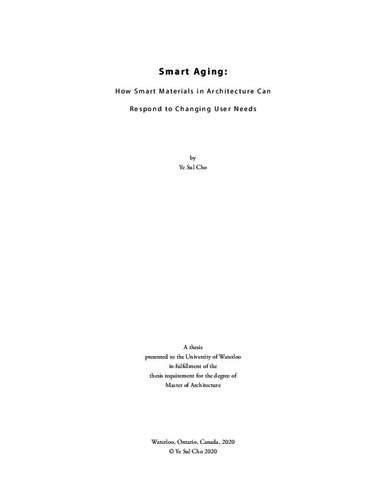UWSpace will be migrating to a new version of its software from July 29th to August 1st. UWSpace will be offline for all UW community members during this time.
Smart Aging: How Smart Materials in Architecture Can Respond to Changing User Needs
| dc.contributor.author | Cho, Ye Sul | |
| dc.date.accessioned | 2020-09-04 18:48:16 (GMT) | |
| dc.date.available | 2020-09-04 18:48:16 (GMT) | |
| dc.date.issued | 2020-09-04 | |
| dc.date.submitted | 2020-08-22 | |
| dc.identifier.uri | http://hdl.handle.net/10012/16262 | |
| dc.description.abstract | As smart materials and digital fabrication technologies advance in architecture, environments can increasingly respond and interact with their users. One area of interest is the development of habitats that respond and adapt to the needs of seniors to create safer environments to age-in-place. With the baby boomer generation reaching retirement age, the problems seniors face in the built environment place a growing pressure on us to reconsider where they live. Few designers, however, apply contemporary technological advancements in architecture to innovate the practical and social environments of seniors. This thesis explores how smart materials can prolong aging-in-place by addressing common environmental problems seniors face in their homes. Rather than considering aging as a barrier of design, this research places seniors as drivers of design inspiration and innovation for creating environments that care for their users. This thesis has three design experiments that follow three parts, each addressing a stage in the design process. The first investigates the relationship of seniors to the built environment through qualitative research and identifies three moments of vulnerability: falling, slipping, and thermo-regulation. The second identifies smart materials that would best respond to mitigating those vulnerabilities through a critical survey of multiple material properties for each moment. It also introduces preliminary design concepts for each intervention using those materials. The final part consists of an iterative cycle between prototyping and designing, resulting in a proof of concept design and prototype for each intervention: lightweight and form fitting protective apparel to protect against falling; a water responsive floor system that enhances grip and indicates wetness to prevent slipping; and a heat and humidity responsive screen system that allows environments to thermally self regulate. Each design experiment grows out of a continuous negotiation between digital fabrication, material behavior, and user needs, reciprocally enriching each other throughout the process. | en |
| dc.language.iso | en | en |
| dc.publisher | University of Waterloo | en |
| dc.subject | smart material | en |
| dc.subject | digital fabrication | en |
| dc.subject | aging in place | en |
| dc.subject | architecture | en |
| dc.subject | human centered design | en |
| dc.title | Smart Aging: How Smart Materials in Architecture Can Respond to Changing User Needs | en |
| dc.type | Master Thesis | en |
| dc.pending | false | |
| uws-etd.degree.department | School of Architecture | en |
| uws-etd.degree.discipline | Architecture | en |
| uws-etd.degree.grantor | University of Waterloo | en |
| uws-etd.degree | Master of Architecture | en |
| uws.contributor.advisor | Correa, David | |
| uws.contributor.affiliation1 | Faculty of Engineering | en |
| uws.published.city | Waterloo | en |
| uws.published.country | Canada | en |
| uws.published.province | Ontario | en |
| uws.typeOfResource | Text | en |
| uws.peerReviewStatus | Unreviewed | en |
| uws.scholarLevel | Graduate | en |

